 |
|
 |
2022
January
30
|
A note on Ptolemy and Copernicus
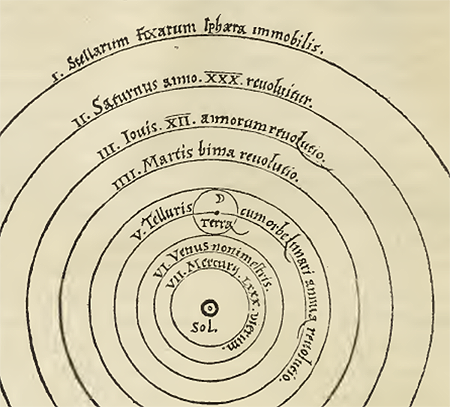
Copernicus was the 16th-century astronomer who convinced everyone that the planets orbit
the sun, not the earth. Ptolemy is the ancient astronomer whose earth-centered system of
orbits was used until that time. Fifty years ago I spent much of the year doing a science
fair project on the relation between the two, and recently I've been reading up on the
subject again. Many excellent studies have come out since the last time I looked, and
general reference books are much more accurate.
Back at mid-century, many books gave the impression that Ptolemy's and Copernicus' systems
were more alike than they were, and that both of them piled up large numbers of epicycles
to deal with trivial inaccuracies. Not so.
It is true that both of them described orbits in terms of a main circle (the deferent) which
carries the center of a smaller circle (an epicycle) which carries the planet itself,
and there could be further layers of epicycles.
This is because they believed non-circular orbits were only physically sustainable as
combinations of perfect circles. But there the similarity ends.
The problem to be solved, for both of them, is this:
(0) As seen from the earth, relative to the distant stars, the sun, moon, and planets go around the
earth eastward, each with its own orbital period, staying close to a line in the sky called the ecliptic.
(1) The orbital motion is not uniform; it is faster on one side of each orbit than the other side.
We see this with all 7 objects (sun, moon, and planets).
(2) What's worse, the motion of the planets is not always eastward.
The inner planets (Mercury and Venus) follow the sun and swing back and forth east and west of it,
moving westward a substantial amount of time.
The outer planets briefly reverse course and move westward for a short time when
opposite the sun.
On (0) everyone agrees. Ptolemy deals with (1) by putting the orbits off-center and deals with (2)
by adding epicycles. For him, Mercury and Venus each follow a main orbit synchronized with the sun-earth orbit
and have an epicycle to account for the east-west swings.
The outer planets have main orbits that are independent of each other, but each has an epicycle
synchronized with the sun-earth orbit.
Copernicus did things quite differently. He dealt with (1) using a small epicycle so that nothing needed
to be off center. More importantly, he made problem (2) disappear by making the earth move.
Then all those other orbits don't need to contain anything synchronized with the sun-earth orbit.
We are simply looking at the effect of the earth's motion.
It's true that Copernicus clung to the ancient and medieval belief that only circular motions could
be sustained eternally. But at least he made his system actually work that way, getting rid of
Ptolemy's clumsy off-center mechanism (where not only the sun but also the center of uniform motion
were not at the center of the circle).
And neither one of them "piled up epicycles" to make minor adjustments. Each epicycle expressed
an important empirical generalization.
I am still researching this subject, and if there are inaccuracies in this entry,
I plan to revise it. Seemingly reliable sources contradict each other, I think partly because the
number of people who have ever actually understood Ptolemy and Copernicus is small.
Permanent link to this entry


|
2022
January
24
|
Colorful pencils

This picture has been hanging in my home office area for a very long time.
I took it on film (in the late 1990s, I think), and then digitized it and made
a color inkjet print, one of the first good inkjet prints I made.
The pencils are, of course, Melody's.
Permanent link to this entry


|
2022
January
17
|
What the law calls "irreparable damage"
I've written some time ago about how, if you disrupt someone's
educational or career progress, there may be no way to make things right again.
It's not like just paying for something you failed to pay for.
Even if you give the person time and funding to do the thing they missed, by then time
has passed, and the person is older, has new opportunities, and needs to be doing something else.
If you've destroyed something like an artist's masterpiece, a writer's manuscript,
or a scholar's research notes,
it's even worse.
Even with time and funding, a do-over of a creative work is not the same as the original.
It's not eligible for the same awards and recognition.
The original may have been recognized for how well it was done with limited time and resources, or
at a specific stage of education; giving extra time changes the whole game.
(Now you have to show what you could do in two years instead of one, and you can never catch up.)
The work may have involved gathering material or having experiences that aren't going to come again,
or the results may be obsolete, or no longer competitive, by the time the do-over is finished.
And the creative person is burdened with having to do the whole thing again.
The do-over isn't what he was planning, wanting, or feeling inspired to do.
It probably prevents him from doing something new that was coming next.
One day I may tell you what brought this to mind.
A piece of my own early scholarly work was lost, not by accident, but through a blunder that
I wasn't involved in making and am still trying to figure out.
Now that we can easily make digital backups and photograph works of art in progress, there's much
less risk of losing creative work than there used to be. Decades ago, even Xeroxing was not
widely available, and it was much
easier to lose the only copy of valuable work.
[Added:] Some years ago I read about a UGA art student whose master's degree project,
a sculpture, was destroyed by vandals after a football game.
Fortunately, it had been photographed, and he got the degree.
But I wonder what else was done or should have been done.
He was, after all, entitled not only to get credit for the artwork, but also to possess it.
The University also probably wanted to exhibit it.
In recent years the University has been more insistent that the Athletic Association must
cover the damage done by football crowds.
But even if he could be paid for his labor, would this art student have wanted to rebuild it himself?
He had other things to do. I don't know whether he planned to keep the sculpture or sell it.
If the latter, well, he's just sold it to the Athletic Association's insurance company,
hopefully for a good price.
Permanent link to this entry


|
2022
January
15
|
How to keep perfume from drying up in the bottle
Today on Melody and Michael's Household Hints...
In the continuing saga of the rare, no-longer-available perfume that I tracked down
for Melody recently...
Here is how to keep it from evaporating and drying up in the bottle.
This particular one had an inner stopper, which we did not realize needed to be kept.
The screw-on cap does not make a tight seal, and we could tell that the level was going
down a little from day to day. (Not all the way down from a full bottle to what you see
in the picture; she has used a fair bit of it.)
We also could smell the perfume outside the bottle even after
allowing a day or two for any that had gotten on the outside to evaporate.
Incidentally, you'll see that the black ink on the label was smudged by tiny amounts of
the perfume itself; they lose points for that!
The cure is to use Teflon plumber's tape (pipe-sealing tape).
This is not sticky tape; it is a soft, clean material, and layers of it join when
pressed together.
In this case we
folded it in half lengthwise and then wrapped several turns around the threads on the bottle.
Just as with plumbing, always use a good bit more than you think there's room for.
Applied once, it can survive having the cap on and off several times, but eventually you'll
have to replace it. If any shows from outside the cap, and you don't want it to, you can trim
it off.
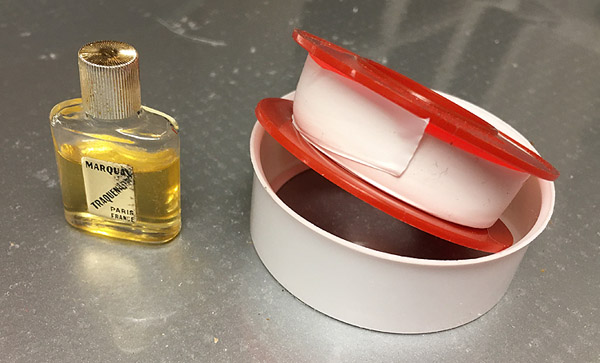

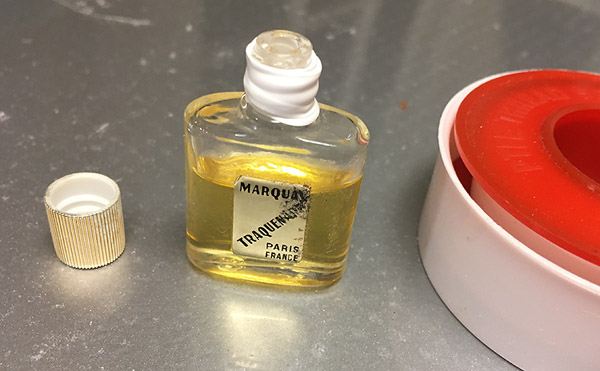
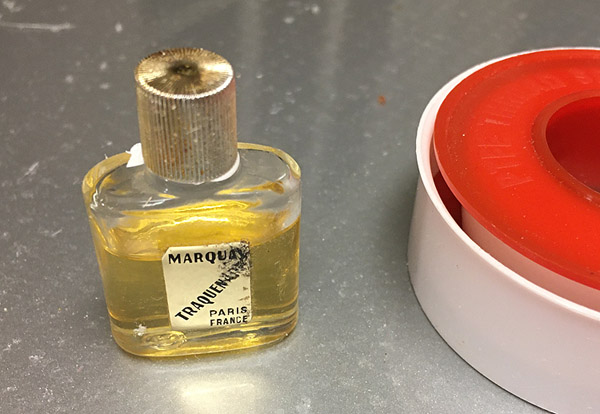
Now what do you add to perfume that has started to dry up, to restore a few drops of lost liquid?
We haven't tried this, but here's what I'm told:
- Not water, which might make it cloudy.
- Not ethyl rubbing alcohol, which contains too much water.
- Not denatured ethyl alcohol from the hardware store, because it is not safe to put on your skin.
- Not pure isopropyl alcohol, which is safe but might smell wrong (opinions differ).
You're supposed to use pure ethyl alcohol (Everclear from the liquor store) or "perfumers' alcohol," which is
ethyl alcohol rendered undrinkable (hence exempt from liquor laws)
by adding a bitter flavoring that is odorless and non-toxic.
That is
a specialty item from perfume makers
but an interesting thing has just happened:
thanks to the COVID epidemic, the same stuff is on the market, cheap in large quantities,
as hand-sanitizer-grade ethanol, nearly pure ethyl alcohol that is safe for skin.
Given the very low price, that stuff probably also has some uses as a cleaner and, of course,
hand sanitizer.
Permanent link to this entry


|
2022
January
11
|
Not to overlook...
Far be it from me to leave unmentioned the national football
championship that my alma mater won last night...

Embroidery by our college friend Keena Lowe, whom we haven't heard from in decades,
but would like to! It's Latin for "Win, O dogs." We decided not to say "Go" because
in that language, it might be taken as meaning "Go away."
Permanent link to this entry


|
2022
January
8
|
Farmington scenery
For our country drive today, Melody and I went to Farmington, south of Athens, and then headed back
toward town on the Old Farmington Road. Let the scenery speak for itself.
|
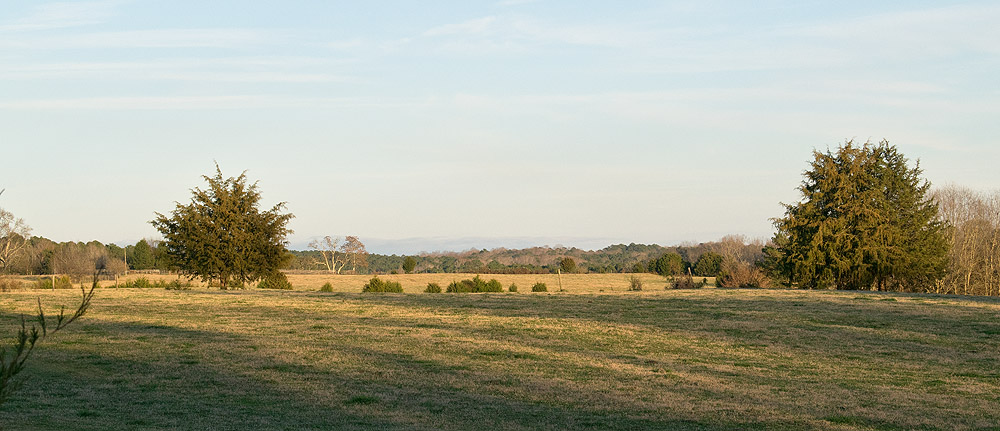
|
| |
|
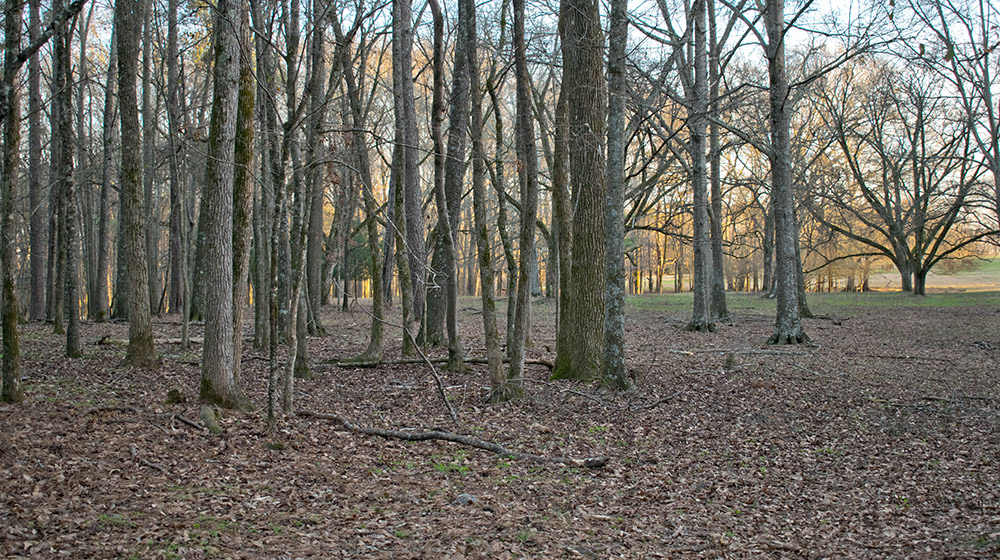
|
| |
Nikon D5300; some local adaptive HDR effects were applied in Photoshop.
Permanent link to this entry


|
2022
January
6
|
Christmas music for Epiphany
(From Facebook.)
Songs of the day (for Jan. 6, which is Epiphany).
First, a philosophical Christmas carol by the late Dan Fogelberg.
The first line sounds like a nonbeliever's solstice celebration —
but keep listening to how it progresses through a series of points.
And if you're not sure he's going to give the complete Christian message, that's what the second song is for.
Look at how precisely the lyrics express things.
Dan Fogelberg, "At Christmas Time"
Dan Fogelberg, "The First Christmas Morning"
I was struck by the very clear Christian message in these two songs.
I never knew Fogelberg identified himself as a Christian, but he did things in those songs
(especially the second one) that I don't think a non-Christian could or would have done.
Permanent link to this entry


|
2022
January
5
|
An astrophotography test session
The strange thing about astrophotography in 2022 is that new versions of software,
firmware, etc., come more frequently than clear nights!
So I am often preoccupied with verifying that new setups work.
So it was on the evening of the 3rd. I set up my GEM45 mount, Askar 200-mm f/4 lens,
Nikon D5500(a), etc., in the driveway.
The guidescope was an SVBony mini-guidescope (30×120 mm) that I had used only once
before; the guide camera, my ASI120MM-S, but connected through USB-2 cables running
through the mount rather than the usual USB-3; the guiding software, a new version of
PHD2; and the computer, my Thinkpad T490s, since I'm finally retiring the almost 9-year-old
Asus UX32A.
Inside the Askar lens I mounted my Orion SkyGlow broadband light pollution filter
(same as what I used on the California Nebula last time), and my main question was whether
it was good for photographing reflection nebulae, which are white and do not have a line
spectrum.
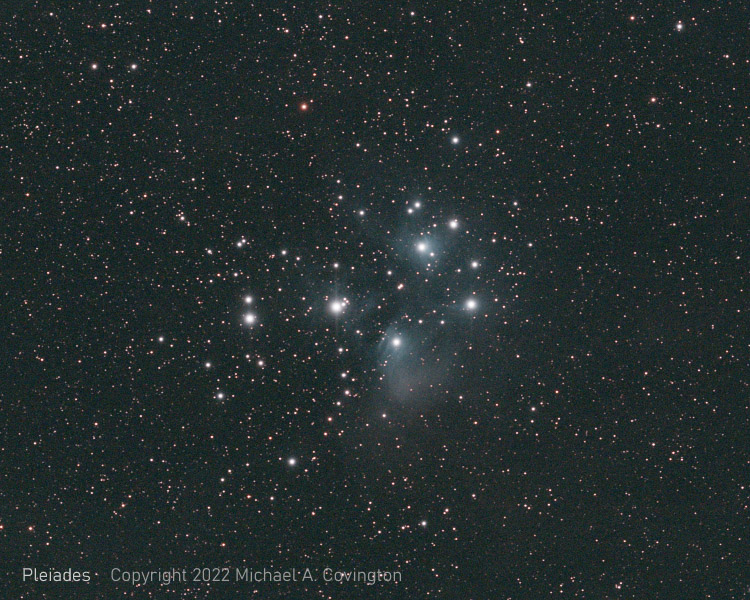
Success! This is a stack of ten 2-minute exposures, and the reflection nebulosity around
the Pleiades is quite visible; you can even see that the thickest part is less bluish.
Since we don't have sodium streetlights any more, I don't know how much good this filter
actually does in such a situation, but it does no harm, and it should have some effect
suppressing the 450-nm deep violet peak of the LED streetlights.
Permanent link to this entry
And a monkey head
The same setup works well with red nebulae, of course. The bright round nebula here is
NGC 2174, the Monkey Head Nebula, in northern Orion. (Up at the top you see IC 443 in Gemini.)
The monkey's head is upside down, and he's facing to your right.
Stack of twelve 2-minute exposures.
|
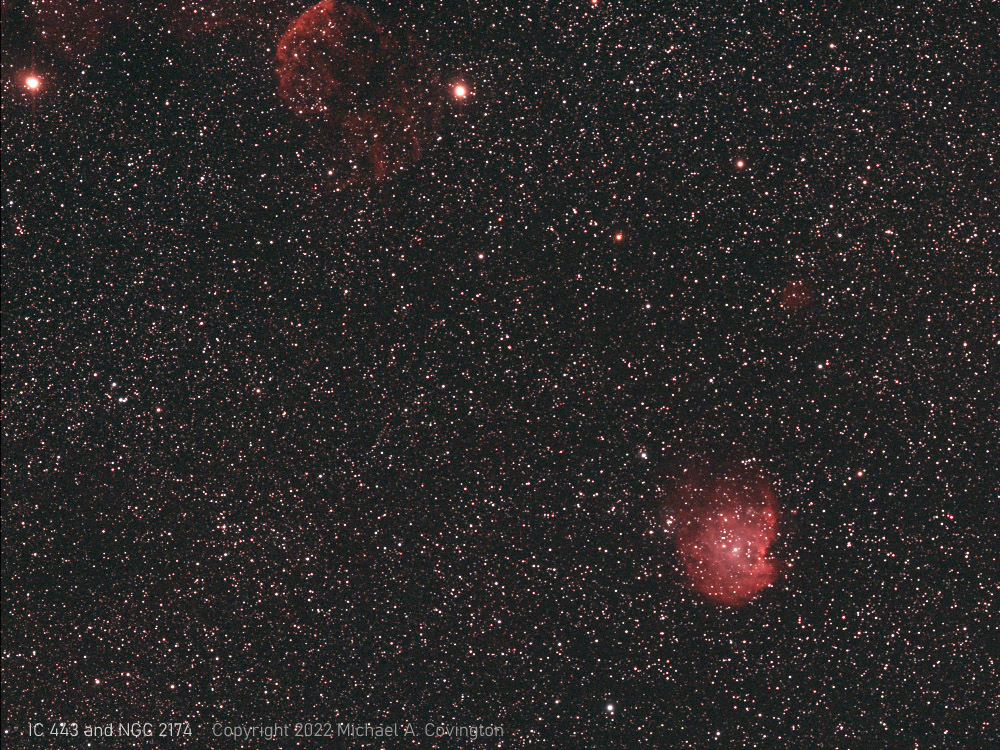
|
| |
Permanent link to this entry
Touchpad unresponsive after accepting an RDP connection
I was controlling the telescope with my ThinkPad T490s, which has Windows 10 Professional
and thus supports Remote Desktop Protocol. While autoguiding was going on, I connected to it
from another computer inside the house, looked at the screen, checked on the progress of
everything, and then disconnected.
Then I went outside, where of course the T490s had its screen locked, waiting for me to
log in. I did so and found the touchpad unusable (although my session was intact and the
autoguiding software had not been disturbed in any way).
The unresponsiveness was present only when I was logged in as myself. Before logging in, the
touchpad worked normally. When I eventually logged out and logged back in again (which would
close the software, so I couldn't try that in the middle of a session), the problem cleared up.
Here is what I've learned:
- This problem is mentioned on a few web sites, for a few brands of computers, going back to 2015.
It is not common, but there is not a definitive fix.
- There are reasons to think a new ELAN touchpad driver will eventually fix it.
- The problem arises only when the T490s has been told to turn off the touchpad when a mouse
is connected. The easiest workaround is to clear that setting. This can be done at any time,
even in the middle of an afflicted session, provided you have some other way of mousing.
- My favorite workaround is actually use the TrackPoint (red button) and left- and right-click
buttons that the ThinkPad provides as an alternative to the touchpad.
They are not affected, and they are easier to use outdoors anyway.
Permanent link to this entry
From pandemic to endemic
We continue to be in an extreme COVID spike, and Georgia has not even reported numbers today, but there
are two grounds for hope. First, it's likely that this spike will be brief.
Second, the Omicron variant is both more contagious and a lot less dangerous than the earlier variants,
especially if you're vaccinated. Thus, it's adding to the population's immunity.
Yesterday, 1/300 of the U.S. population tested positive.
If a typical case lasts 15 days and gets tested only once, then 1/20 of the population has COVID
right now. That is a low estimate because mild cases don't get tested, and tests are in short
supply. So it is not unreasonable to guess that 1/5 of Americans have COVID right now!
Many have mild or no symptoms, of course.
We are going to have to shift our tactics in several ways.
Here's what I think we should do.
- During the peak, be prepared for a shortage of workers in all types of jobs.
Vaccinated people who get Omicron have flu-like symptoms for a few days and should stay home.
- During the peak, also be prepared for a shortage of medical care.
There are enough unvaccinated people to fill up the hospitals
themselves, not to mention people with underlying conditions who need extra care for even a
fairly mild case of COVID.
- Move away from isolating individuals who test positive or have been exposed and are not sick.
The reason? We are all exposed several times a day, and for everyone who tests positive, there are
many more walking around who have mild or asymptomatic cases.
- Emphasize limiting the spread everywhere, whether or not people know they have the virus.
- Keep trying to persuade people to get vaccinated.
I hope society will emerge from all this with some new habits.
Just as the polio epidemic 70 years ago taught us that dirty
bathrooms are dangerous, today we need to realize that needless crowding is unsanitary,
sick people shouldn't come to work, and colds aren't for sharing.
Permanent link to this entry


|
2022
January
1
|
A dramatic cloud over East Athens

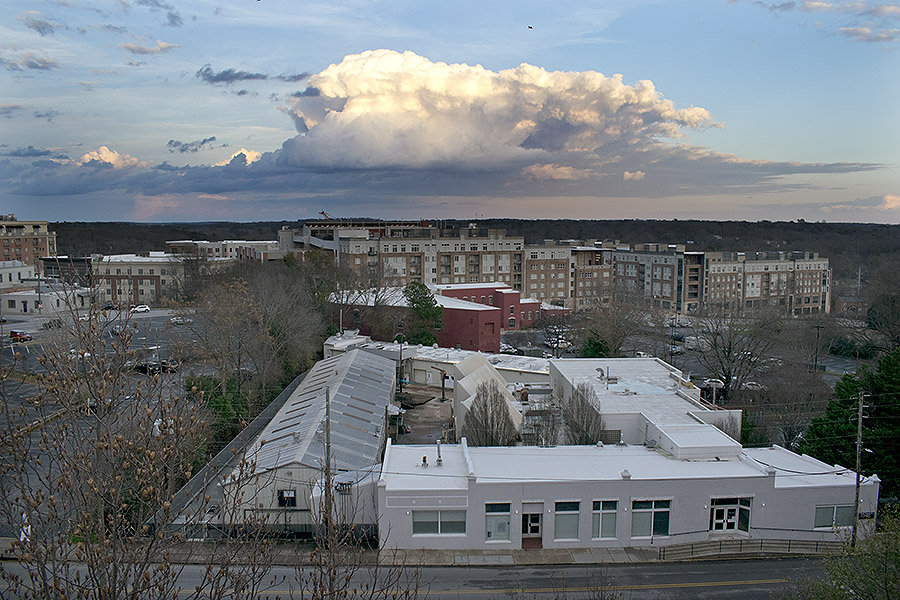
Taking advantage of the warm weather (76 F) and the fast-changing lighting due to
fast-moving clouds, Melody and I decided to go on a photography expedition and
ended up on the top level of the Jackson Street
parking deck, more or less directly above the site of the old Graphic Design
Annex in which she did much of her studio work as a student. This cloud caught our eye.
Nikon D5300, 18-55mm zoom lens.
In the second picture, you see, in the foreground, a building on Thomas Street
that belongs to the School of Art; that's where Melody studied sculpture.
Beyond it is a big, luxurious apartment building recently built on the site
of the old Armstrong and Dobbs lumberyard.
Permanent link to this entry


|
|
|
This is a private web page,
not hosted or sponsored by the University of Georgia.
Copyright 2022 Michael A. Covington.
Caching by search engines is permitted.
To go to the latest entry every day, bookmark
http://www.covingtoninnovations.com/michael/blog/Default.asp
and if you get the previous month, tell your browser to refresh.
Portrait at top of page by Sharon Covington.
This web site has never collected personal information
and is not affected by GDPR.
Google Ads may use cookies to manage the rotation of ads,
but those cookies are not made available to Covington Innovations.
No personal information is collected or stored by Covington Innovations, and never has been.
This web site is based and served entirely in the United States.
In compliance with U.S. FTC guidelines,
I am glad to point out that unless explicitly
indicated, I do not receive substantial payments, free merchandise, or other remuneration
for reviewing or mentioning products on this web site.
Any remuneration valued at more than about $10 will always be mentioned here,
and in any case my writing about products and dealers is always truthful.
Reviewed
products are usually things I purchased for my own use, or occasionally items
lent to me briefly by manufacturers and described as such.
I am no longer an Amazon Associate, and links to Amazon
no longer pay me a commission for purchases,
even if they still have my code in them.
|
|
















